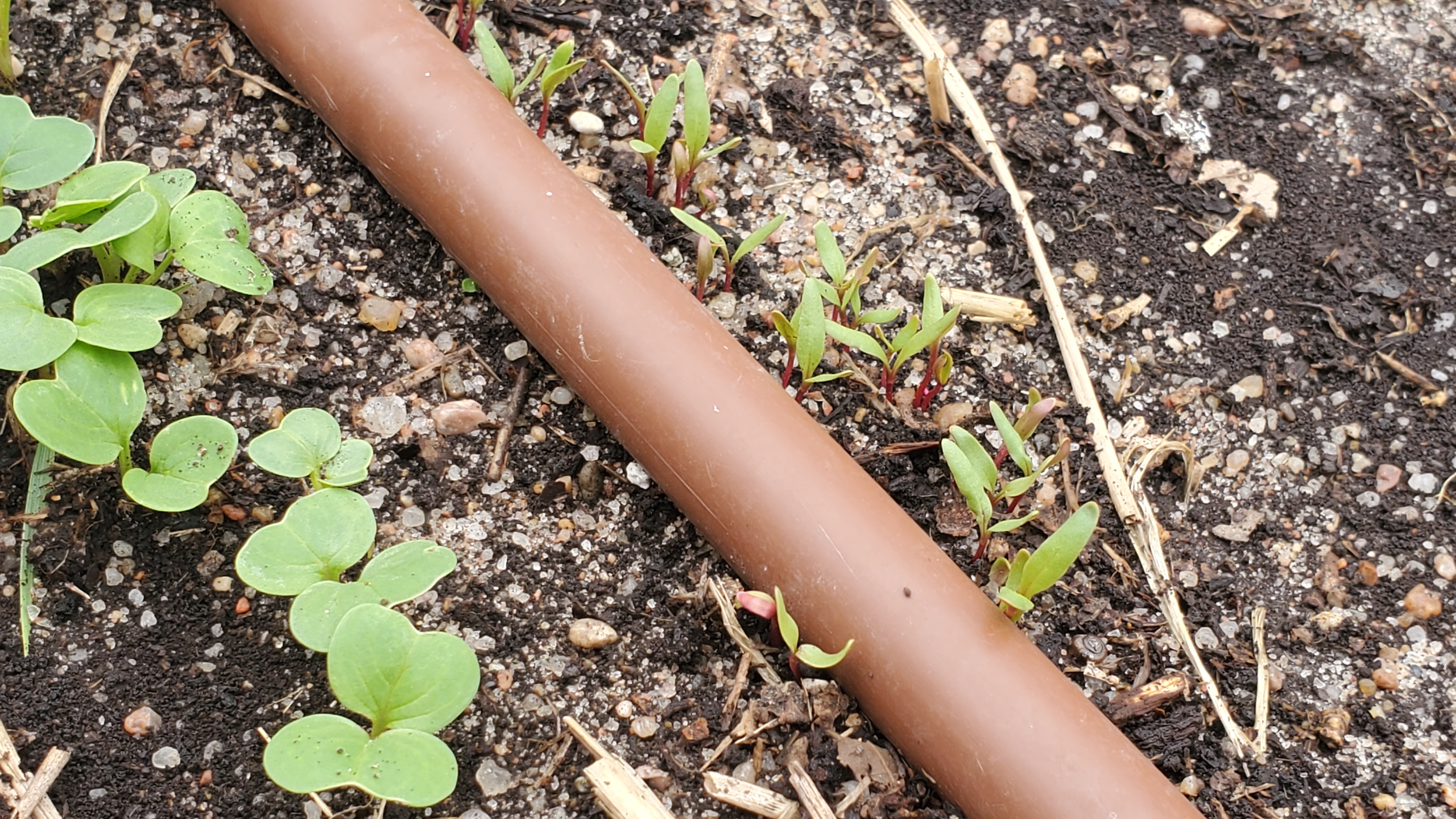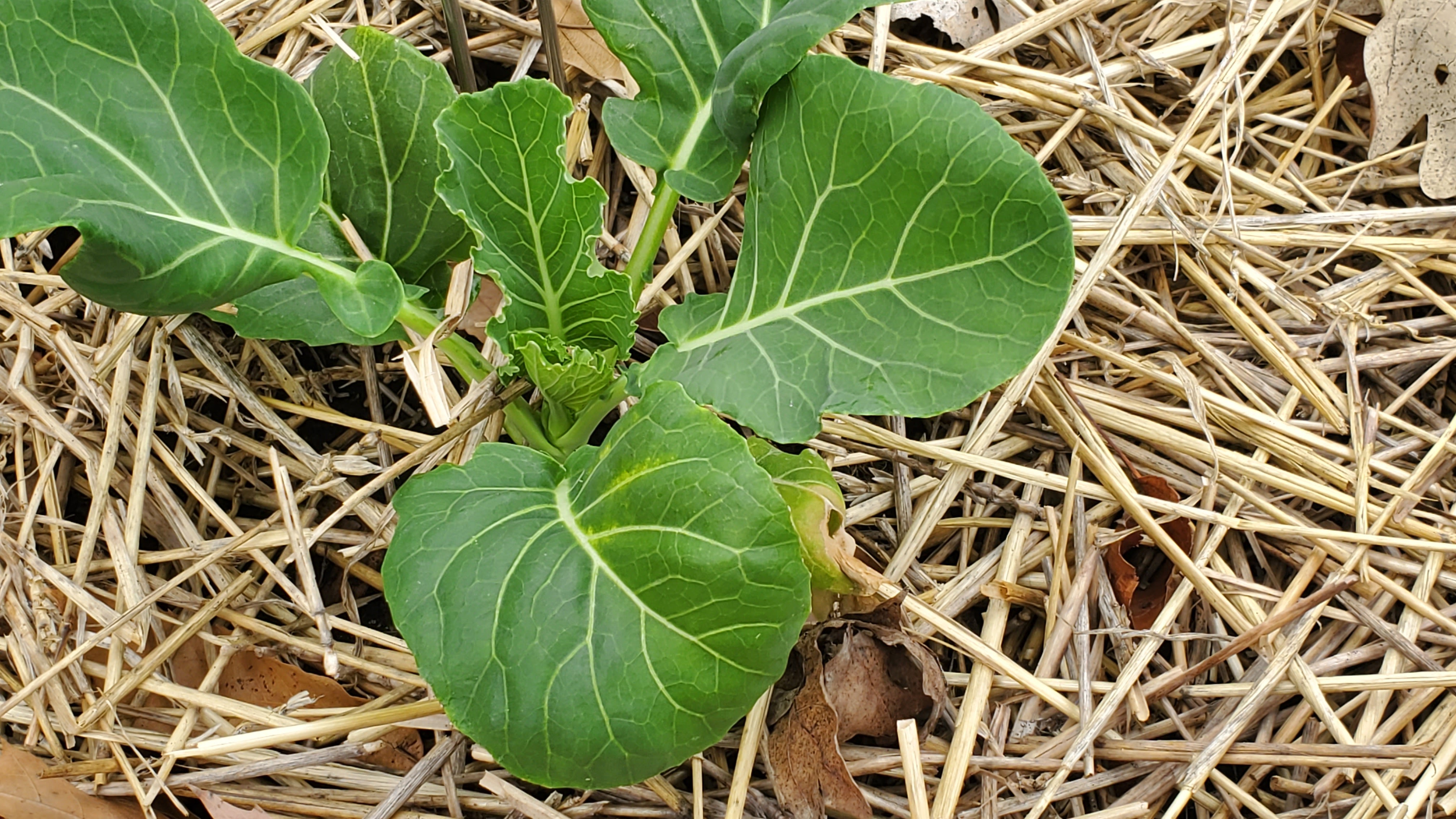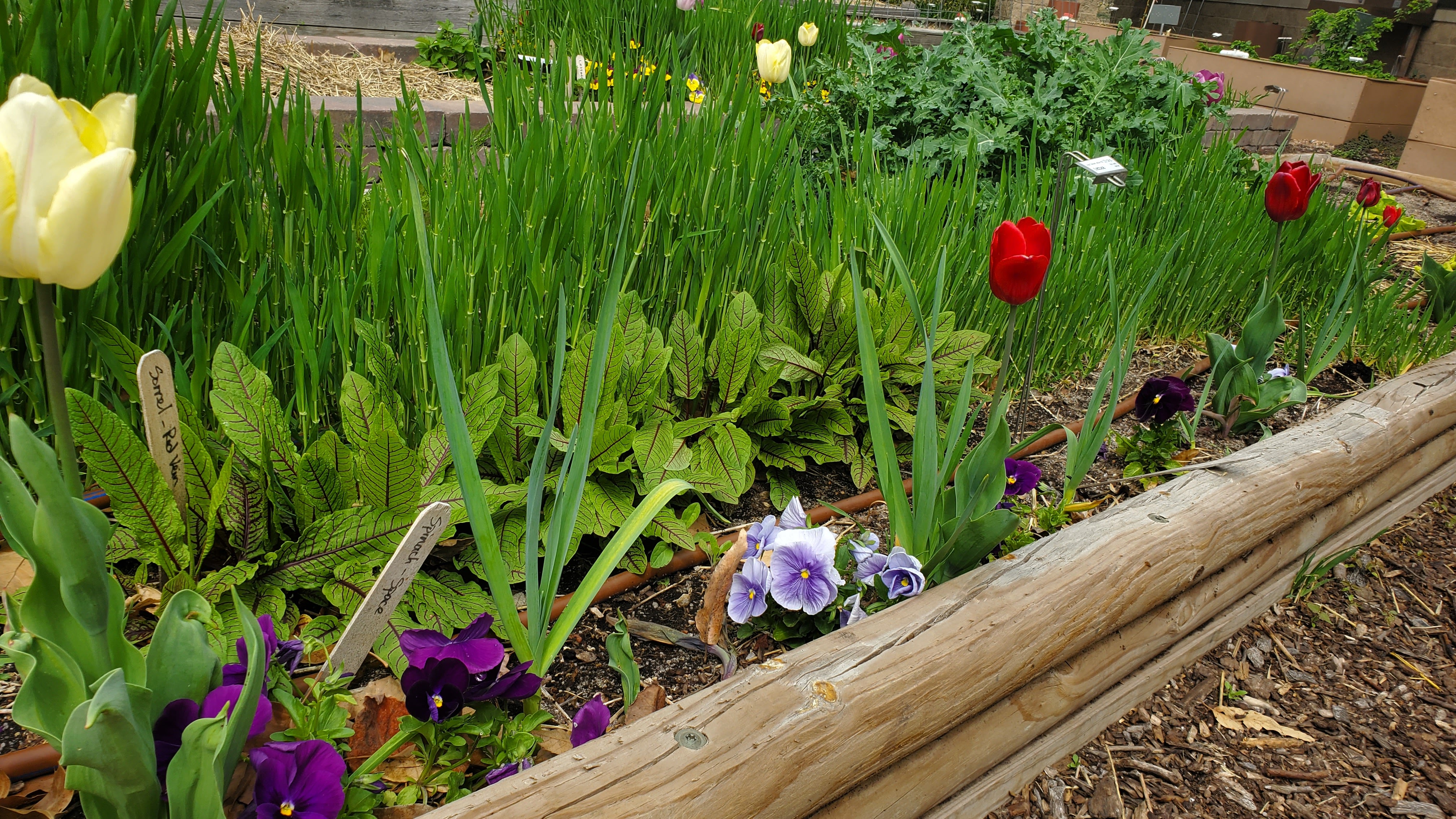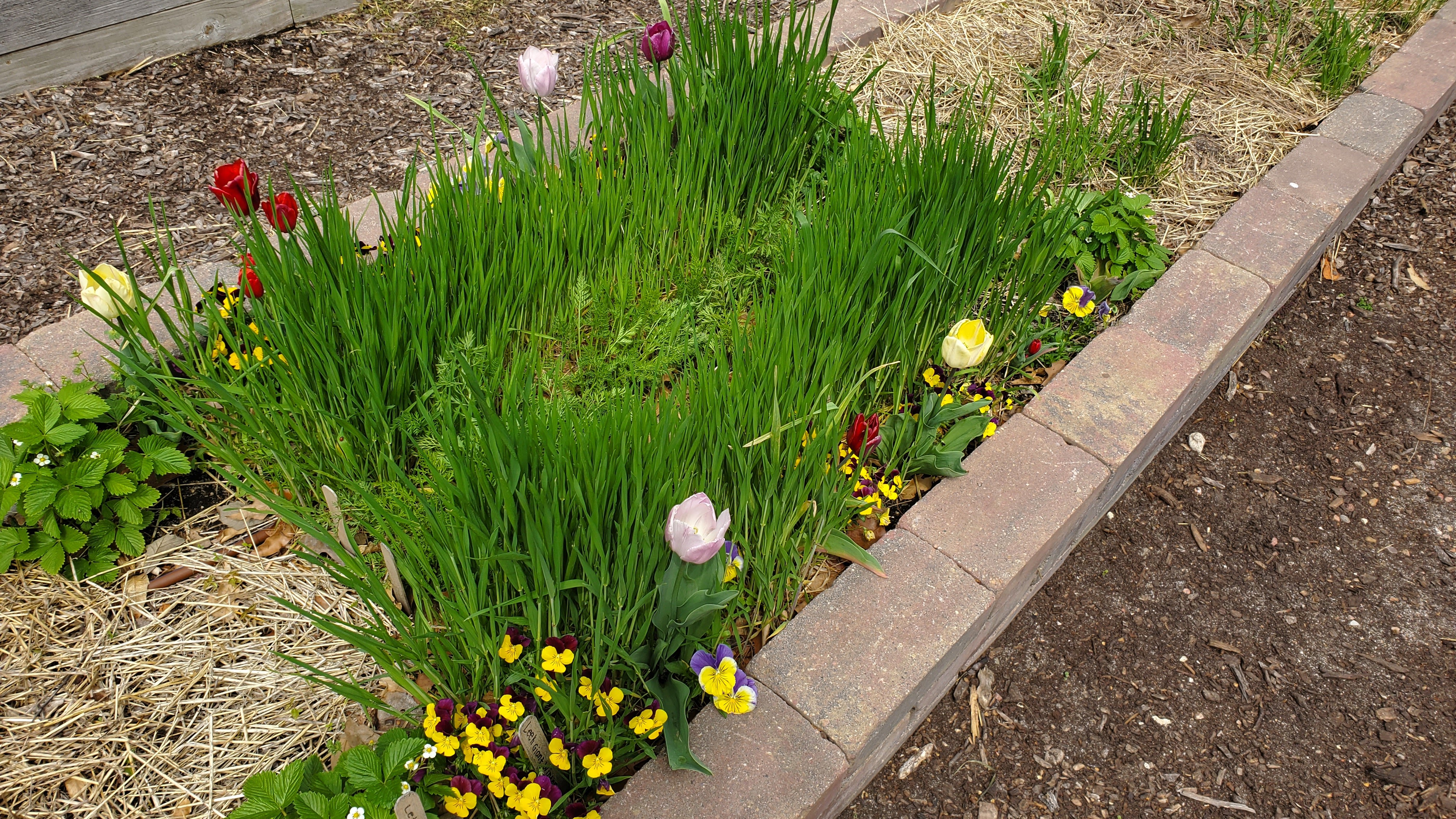Category Archives: Around the Garden
2021 Demo Garden Plans and Updates
Our Demo Garden plantings are well underway for this year, and we already have some exciting things to showcase. But first – here’s a quick overview of what we are planning to grow this year!

We chose to continue to focus our garden efforts on productivity and yield over diversity for this year. We are planning to continue donating our harvests to the Common Ground Producers & Growers Mobile Market for their Seniors First food box program, which provides free food boxes to low income seniors.
With that in mind, we are keeping each garden bed to only a couple different types of produce, although we still have more diversity of varieties than you might otherwise see. We are also focusing on interplanting and succession planting to use our space well. For example, in bed 1, we have radishes planted between rows of beets and carrots and IN the row with the parsnips to use every square inch of space. In Bed 2, we are filling the space with lettuce and spinach now, and then the peppers for the remainder of the season will be planted into the leafy greens while they finish their spring season. In Beds 4 and 5, we have planted broccoli, cauliflower, and peas under the trellises that will hold the cucumbers and squash later in the summer to get an additional crop out of those spaces.
The Master Gardeners have been hard at work getting the garden into shape for the spring, and almost all the beds have either seeds or transplants already growing. We had covered most of the beds with straw last fall, so that is both good and bad now – the soil stays moist with the straw, but we have lots of wheat seedlings growing. We also needed to move quite a bit of the straw around to facilitate seed planting.
The other thing I’m excited to show off a little bit are a couple of the school garden templates that I developed last year and planted last fall.
The templates are 4×8 layouts designed with high diversity (and relatively low productivity) for better interest and learning experiences in a school garden setting. (You can see all the templates and supporting information here: Kansas School Garden Guide.) Both of the templates shown here were designed to be planted last fall and overwintered. These overwintered with NO additional protection from the elements. They include pansies, tulips, garlic, shallots, alpine strawberries, barley or wheat, and vegetables (kale, carrots, red-veined sorrel, spinach).
If you haven’t been out in awhile, our garden is always open to the public – best viewed during daylight hours! Things will be changing fast as it gets warmer, so don’t miss out on the opportunity to visit.
What we’re harvesting

“The fruit derived from labor is the sweetest of pleasures.”
This quote from Luc de Clapiers perfectly sums up harvest in the Demo Garden! Our wonderful team of Extension Master Gardener volunteers has figured out how to navigate the difficult circumstances due to COVID and still have a very beautiful, productive garden. The fruits of our labor are gratifying to see and it is rewarding to pass on the fresh produce to those in need – more on this later!
So, what’s being harvested right now? Cucumbers, eggplant, tomatoes, peppers galore and more! This past week in the garden, I picked a small sample to bring home and taste test.

The peppers in the garden are starting to produce exceedingly well. There are many varieties being grown in the Demo Garden, but I tried just four. Since I’m not personally a hot pepper fan, I left those varieties alone and focused on some of the sweet pepper varieties: ‘Cornito Giallo,’ ‘Ajvarski,’ ‘Mad Hatter,’ and ‘Eros.’


‘Cornito Gaillo’ is a 5” yellow orange pepper that is outstanding raw, but roasting especially brings out the sweetness of this pepper. ‘Eros,’ a mini bell pepper, was remarkably tasty. The 2” orange fruit was distinctly sweet when roasted, and had an enjoyable taste uncooked. ‘Ajvarski’ is a sweet red 5” pepper. While this traditional Macedonian roasting pepper was quite tasty when roasted, it was also particularly delicious eaten fresh. ‘Mad Hatter’ – such a fun name – is so charming to look at that it could even be grown as an ornamental plant! Who can resist its 2” uniquely shaped pepper, best picked when red. (Picked green, it was slightly disappointing in flavor.)


Horticulturally speaking, our peppers have not yet endured any pests or diseases in the garden. They have tolerated the heat well, have set an impressive amount of fruit, and are all together going strong! Not every pepper variety grows easily in Kansas, but in general, they do very well here, as evidenced by the plants in the Demo garden, and the plethora of peppers you can find at the farmers markets right now. There are SO many varieties, we could probably fill the whole Demo garden trying different kinds!

Cucumbers have produced marvelously in the garden this season. ‘Sweet Success’ is a 12” cucumber that has a nice crunch and mild taste. The seeds are so small, they are hardly detectable. ‘Summer Dance’ is a 9” variety of cucumber. The seeds are extremely small and not obvious when eating, and it also has a pleasing crunch. ‘Salt and Pepper’ is a unique white variety that turns slightly yellow the longer it is left on the vine. Normally, cucumbers that turn yellow have passed their prime and can be quite bitter and off-putting, but that’s not the case with ‘Salt and Pepper!’ Even though the seeds are noticeable in more mature, yellow fruits, the flavor remains phenomenal despite the color.




‘Salt and Pepper’ fruits are not only very tasty, but their vines have been very healthy and prolific producers this season. ‘Summer dance’ has also grown well, but I think ‘Salt and Pepper’ takes the cake. We have not had many issues growing cucumbers in the Demo garden this season; they get ample water through our irrigation system, which can sometimes be a hindrance for other growers – cucumbers are thirsty plants!

I’m not usually a big fan of eggplants, mostly because I don’t care for the soft texture, but I might change my mind after sampling ‘Orient Charm,’ an oblong purple eggplant about 5” long. There were no detectable seeds; when roasted, it had an enjoyable flavor and remained a slightly more firm than most eggplants do. ‘Annina’ is another unique eggplant currently producing very well. The variegation on the skin makes it a delight to the eyes, rivaling some flowers in its beauty! When roasted, it was soft like most eggplants are but did have a pleasing flavor. If you like the soft texture of eggplant then this variety will not fail to please.




Overall, our eggplant plants have grown very well. We had a stint of eggplant lace bugs earlier in the season, but a few rounds of forceful water sprays on the under sides of the leaves has kept the population in check. This pest usually only causes significant damage in very large numbers; the population is low enough now that there is some of the characteristic stippling on the leaves, but not enough to hamper eggplant production.


We will have an in-depth post about the tomatoes we trialed this year in the coming weeks, but I sampled a couple varieties and will share briefly about them here. ‘Chef’s Choice’ is an AAS (All-America Selections) winner that comes in a variety of colors. ‘Chef’s Choice Orange’ had great flavor with pleasant tomato tang. ‘Chef’s Choice Red’ had a bit more sweetness to it that was pure delight to the taste buds. ‘San Marzano II,’ an Italian heirloom variety, is great for canning because it doesn’t have quite the water content of the other two varieties, which is typical of a good paste tomato. I found that ‘San Marzano II’ raw was rather bland; paste tomatoes are not usually eaten raw since their flavor is enhanced with cooking.


So, what do we do with all this wonderful produce we harvest? Besides some samples that the Master Gardeners occasionally take home, the majority of our harvest is donated to a wonderful organization and community partner of the Extension Office, Common Ground Mobile Market.


The Mobile Market delivers fresh, locally grown produce to seniors in the greater Wichita area. They make eating healthy accessible to folks who otherwise might find it difficult to get to the store or afford high quality produce. We are so grateful to be able to add our harvest to their wonderful work in the community, as they are providing an incredible service during this especially difficult time. You can learn more about the work they do here: https://www.commongroundpg.com/.
Author: Maureen Wilbeck
Beans: from garden to plate
Beans are a Kansas favorite in the vegetable garden. These warm-season plants are well acclimated to our tough Kansas summers. Once planted, they grow very fast and most varieties are ready to harvest in seven to eight weeks.

In the Demo Garden, beans are starting to produce. It is best to harvest when the pods are firm and crisp, but the bean seeds are not yet bulging. If at all possible, don’t pick them in the early morning when there is dew on the plants, as blight, a common bacterial disease, can easily be spread from one plant to another via splashing water droplets. So, make sure the plant foliage is dry before harvesting.
Green beans are typically grown for their immature pods. Beans such as navy and lima beans are allowed to fully ripen and then the bean seeds are removed from the pods; these types of beans are harvested much later in the season.

On April 28th, we planted four different varieties of bush style green beans (also called snap beans) in the Demo Garden: Heavy Harvest, Tenderette, Royal Burgundy, and Tendergreen Improved.
‘Heavy Harvest’ is a 53-day bean. This medium green-colored bean is also slender and grows about five inches long. So far, it is not living up to its namesake in that it has only yielded a small amount of beans so far.
‘Tenderette’ is a 58-day variety of bean. It also grows about five inches long and is slender. It is medium green in color. As with Heavy Harvest, this too only had a few ready to be picked.
‘Royal Burgundy’ is a 55-day variety that generally grows about five inches long. It is a slender bean with a deep purple coloring that is very beautiful and makes it very easy to see against the green foliage. Again, there were only a handful of beans to be found, but we are hopeful that with a little more time, they will start producing more.



‘Tendergreen Improved’ is a 52-day variety. The coloring, although still green, had a bit of a lighter, yellowish undertone compared to the other green beans. These beans are a little longer, growing up to six inches in length and is also plumper than the other varieties. The thing that is most impressive about Tendergreen so far is the yield. While it makes sense that there are more harvestable beans of this variety right now because its “days to maturity” (DTM) is shorter, this variety is still likely to out-produce the other varieties – but we will keep you updated!

So how do they cook up? Using a quick, identical technique on each variety, we tested them “tender-crisp” style. After the ends were trimmed, a ¼ cup water was added to a skillet along with the beans and cooked covered for three minutes. Then the cover was removed to allow the water to fully evaporate. A touch of butter was then added to each.
My personal favorite is the Tendergreen Improved. It was the most tender of the four varieties tested as well as the most prolific producer. Tenderette and Heavy Harvest where just slightly tougher than Tendergreen. Although the most unique to look at, the Royal Burgundy was the toughest of all the varieties, but interestingly, it turns from purple to green when cooked.

One final note: there was some significant stippling on the leaves of the beans, which is an indicator of spider mites. Spider mites are tiny, barely visible spider-relatives that suck juice from the underside of leaves and are common during hot, dry weather.

As a first defense against this garden pest, after harvesting the beans, we used the garden hose with a jet spray setting and shot the underside of the leaves with as much coverage as possible, and we plan to repeat this process a few times a week. Hopefully these pesky critters won’t ruin the harvest!

Click here to learn more about growing beans or spider mites.
By: Maureen Wilbeck, Master Gardener
Purple Sprouting Broccoli
Broccoli is one of those vegetables that can be a little bit “hit or miss” in Kansas, especially in the spring. The cool parts of the growing season, spring and fall both, can sometimes be too short and too erratic to have great broccoli. Over the years we have tried several kinds of broccoli, some that performed well and others not so much.
This year, we chose to plant ‘Burgundy,’ a variety of purple sprouting broccoli. Sprouting broccoli is selected for high quality, uniform, and prolific side shoots. Many older “heading type” broccoli varieties would produce some side shoots, newer varieties not as much. Sprouting broccoli is designed to have the center “head” shoot pinched out at a small size to encourage more side shoots.
 We started these plants from seed in mid-February and transplanted them into the garden on March 17th. They are supposed to take about 37 days from transplant to maturity…but the weather was definitely not helpful on that front this year. About a week ago, the plants were showing the development of the center shoot. (About 60 days after transplanting – thanks, cold snaps!)
We started these plants from seed in mid-February and transplanted them into the garden on March 17th. They are supposed to take about 37 days from transplant to maturity…but the weather was definitely not helpful on that front this year. About a week ago, the plants were showing the development of the center shoot. (About 60 days after transplanting – thanks, cold snaps!)
 I snipped out the center stalk, and you can already see the side shoots starting to grow.
I snipped out the center stalk, and you can already see the side shoots starting to grow.
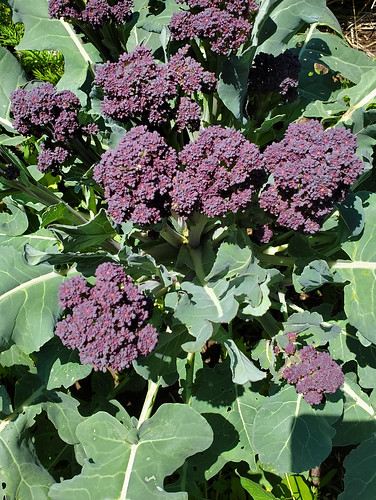 This is what the shoots are looking like now. I love the purple color! So often with purple vegetables, the color is disappointing, but this is beautiful. It is important to note that the color will fade to a beautiful dark green once it is cooked.
This is what the shoots are looking like now. I love the purple color! So often with purple vegetables, the color is disappointing, but this is beautiful. It is important to note that the color will fade to a beautiful dark green once it is cooked.
From a flavor standpoint, this broccoli is strong. The little bit that I have nibbled on, it has a very strong mustard flavor. Most homegrown broccoli is that way, and once it is cooked, it has great flavor – but it is not the mild and water flavor you maybe have come to expect from even fresh grocery store broccoli.
The idea with the side shoots is that they should continue to develop and be produced until it gets too hot, potentially having a higher yield for a single plant than with a heading type.
If you wanted to give this plant a try (and you can find the seeds available!), you should start the seeds indoors in mid- to late June, then transplant outside in late July. With some luck and decent weather, you should have some awesome broccoli sometime in September!
2020 Tomato Trials
Our tomato trials are looking very fortuitous at this point in the year. When we were planning this winter, we chose to try out some of the more recent All-America Selections tomato winners. These are varieties that have been tested all across the U.S. and have shown to perform reliably under a wide range of conditions.
We had already grown Chef’s Choice Orange a couple of times and found it to be a reliable producer with great flavor. (I have also grown it at home for a few more years and it has quickly become one that is an easy choice.) 
With that experience, we are interested to see if other, new varieties in the Chef’s Choice line will be just a promising for Kansas. We chose to grow the Chef’s Choice Orange again as our “known” trial variety. To that, we have added the following varieties. (Links to the All-America Selections pages, with more variety details.)
Chef’s Choice Red – 8 oz fruit, prolific
Chef’s Choice Green – Green and yellow at maturity and citrus-y flavor common to green-when-ripe tomatoes.
Chef’s Choice Yellow – 10 oz. somewhat sweet fruit
Chef’s Choice Pink – 12-14 oz beefsteak with pink skin and flesh
We also chose two non-Chef’s Choice varieties to test in order to have a broader comparison.
Galahad – Red fruit with high disease resistance and purported crack resistance. (Crack resistance is a hot commodity in Kansas, so we are hoping for great things!)
Mountain Rouge – From the “Mountain” series, a 12-14 oz. pink beefsteak with high disease resistance.
Some Cherry Tomatoes:
In other areas of the garden, we also have some cherry tomatoes planted, and these are a little further outside the normal varieties.
Moonbeam – A pale yellow or white grape tomato that is supposed to have high yields and exceptional flavor.
Brad’s Atomic Grape – This multi-colored tomato has been all over social media for a couple years, but we have heard from some locals that it cracks horribly. So…we’re going to give it a try!
Blush – A yellow oblong cherry with red stripes and interior blush. We have tried others in this series in the past, all with bad cracking problems, so it will be interesting to see how this one performs.
If all goes well, we hope to have a bounty of tomatoes this year, as well as some great new varieties to recommend in our area.

